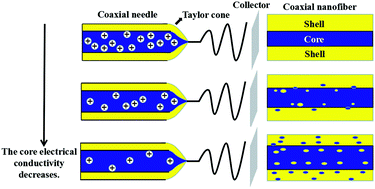Effect of the electrical conductivity of core solutions on the morphology and structure of core–shell CA-PCL/CS nanofibers
Abstract
Core–shell structured cellulose acetate-polycaprolactone/chitosan (CA-PCL/CS) composite nanofibers were electrospun via coaxial electrospinning. Different solvents were used in core solutions, which led to different electrical conductivities in core solutions. The effect of the electrical conductivity on the morphology and structure of core–shell fibers was studied emphatically. As shown in the scanning electron microscopy (SEM) and transmission electron microscopy (TEM) images, the increasing electrical conductivity of core solutions would result in smaller diameter ratios of core to shell, thinner overall diameters and more inhomogeneous diameter distributions. Additionally, Fourier transform infrared spectroscopy (FTIR), X-ray photoelectron spectroscopy (XPS), X-ray diffraction (XRD) and differential scanning calorimetry (DSC) all demonstrated that the interactions between cores and shells weakened with the increase of electrical conductivity of core solutions, and this might lead to different diameter ratios of cores to shells in the fibers. The results provide a basis for further design and optimization of processing conditions to control the nanostructure of core–shell composite nanofibers.



 Please wait while we load your content...
Please wait while we load your content...